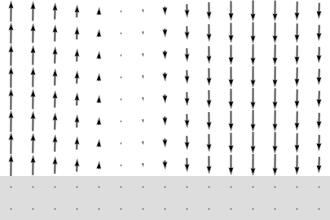Zenneck wave
The Zenneck wave, Zenneck surface wave or Sommerfeld-Zenneck surface wave is a longitudinal, inhomogeneous or non-uniform electromagnetic plane wave incident at the complex Brewster's angle onto a planar or spherical boundary interface between two homogeneous media having different dielectric constants.[1][2][3][4][5][6][7]:p. 198

The Zenneck wave propagates parallel to the interface and decays exponentially vertical to it, a property known as evanescence. It exists under the condition that the permittivity of one of the materials forming the interface is negative, while the other one is positive, as for example the interface between air and a lossy conducting medium such as the terrestrial transmission line, below the plasma frequency. Arising from original analysis by Arnold Sommerfeld and Jonathan Zenneck of the problem of wave propagation over a lossy earth, it exists as an exact solution to Maxwell's equations.[8]
See also
- Longitudinal wave
- Body-centric wireless network
- Surface plasmon
- Surface wave
- Wireless energy transmission
References
- Sommerfeld, Arnold, "Uber die Ausbreitung der Wellen in der Drahtlosen Telegraphie" (Tr. The Propagation of Waves in Wireless Telegraphy), Ann. Physik [4] 28, 665 (1909); 62, 95 (1920); 81, 1135 (1926).
- Zenneck, Jonathan, "Über die Fortpflanzung ebener elektromagnetischer Wellen längs einer ebenen Leiterfläche und ihre Beziehung zur drahtlosen Telegraphie" (Tr. "About the propagation of electromagnetic plane waves along a conductor plane and their relationship to wireless telegraphy"), Ann. Physik [4] 23, 846 (1907).
- Goubau, G., "Über die Zennecksche Bodenwelle," (Tr. On the Zenneck Surface Wave), Zeitschrift für Angewandte Physik, Vol. 3, 1951, Nrs. 3/4, pp. 103-107.
- Barlow, H.; Brown, J. (1962). "II Conditions for the Support of Surface Waves at an Interface Between Two Different Homogeneous Media". Radio Surface Waves. London: Oxford University Press. pp. 10–12.
- Collin, R.E. (2004). "Hertzian Dipole Radiating Over a Lossy Earth or Sea: Some Early and Late 20th Century Controversies," IEEE Antennas and Propagation Magazine, vol. 46, No. 2, April 2004, pp. 64-79. "There is no sign error . . . The famous 'sign error' is a myth."
- Corum, K.L., M.W. Miller, and J.F. Corum, "Surface Waves and the 'Crucial' Propagation Experiment," Proceedings of the Texas Symposium on Wireless & Microwave Circuits & Systems, IEEE Microwave Theory and Techniques Society, Baylor University, Waco, Texas, March 31-April 1, 2016.
- Corum, K.L. and J.F. Corum, “Bell Labs and the ‘Crucial’ 1936 Seneca Lake Experiment.” (Published in Nikola Tesla’s Electricity Unplugged as “Bell Labs and the Radio Surface Wave Propagation Experiment,” Thomas Valone, Ed., Adventures Unlimited Press, 2016.) "Any source that can synthesize fields incident at this complex angle will launch a Zenneck wave."
- Barlow, H.; Brown, J. (1962). Radio Surface Waves. London: Oxford University Press. pp. v, vii.